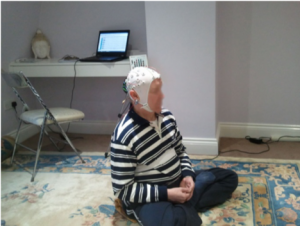Reduce Current Depressive Symptoms with Mindfulness
By John M. de Castro, Ph.D.
“Depression is not only the most common mental illness, it’s also one of the most tenacious. . . But a growing body of research is pointing to an intervention that appears to help prevent relapse by altering thought patterns without side effects: mindfulness-based cognitive therapy, or MBCT.” – Stacy Lu
Clinically diagnosed depression is the most common mental illness, affecting over 6% of the population. Depression can be difficult to treat and is usually treated with anti-depressive medication. But, of patients treated initially with drugs, only about a third attained remission of the depression. But drugs often have troubling side effects and can lose effectiveness over time. In addition, many patients who achieve remission have relapses and recurrences of the depression. Even after remission some symptoms of depression may still be present (residual symptoms).
Being depressed and not responding to treatment is a terribly difficult situation. The patients are suffering and nothing appears to work to relieve their intense depression. Suicide becomes a real possibility. So, it is imperative that other treatments be identified that can relieve the suffering.
Mindfulness training is an alternative treatment for depression. It has been shown to be an effective treatment for depression and its recurrence and even in the cases where drugs fail. Mindfulness-Based Cognitive Therapy (MBCT) was specifically developed to treat depression. MBCT involves mindfulness training, containing sitting, walking and body scan meditations, and cognitive therapy that attempts to teach patients to distinguish between thoughts, emotions, physical sensations, and behaviors, and to recognize irrational thinking styles and how they affect behavior. MBCT has been found to be effective in treating depression. The research is accumulating. So, it makes sense to take a look at what has been learned.
In today’s Research News article “Mindfulness-based cognitive therapy for the treatment of current depressive symptoms: a meta-analysis.” (See summary below or view the full text of the study at: https://www.ncbi.nlm.nih.gov/pmc/articles/PMC6687569/ ) Goldberg and colleagues review, summarize, and perform a meta-analysis of the published randomized controlled trials of the effectiveness of Mindfulness-Based Cognitive Therapy (MBCT) for current depression. They identified 13 published controlled studies.
They report that the published studies found that Mindfulness-Based Cognitive Therapy (MBCT) produced significant improvements in depressive symptoms when compared to non-specific control conditions; those that did not suggest therapeutic effects. On the other hand, compared to control conditions in which the condition was portrayed as therapeutic, MBCT produced equivalent reductions in depressive symptoms. They also report that the improvements do not last and were no longer present at follow-ups as long as 6 months post-treatment.
The results suggest that Mindfulness-Based Cognitive Therapy (MBCT) is a safe and effective treatment for current depressive symptoms. But it does not appear to be superior to other therapies and does not have lasting efficacy. This suggests that further research needs to be performed to determine what are the components of therapy that produce improvements and which do not. They also suggest that booster treatments periodically after the primary treatment may be needed to maintain effectiveness.
So, reduce current depressive symptoms with mindfulness.
“Mindfulness-Based Cognitive Therapy (MBCT) is designed to help people who suffer repeated bouts of depression and chronic unhappiness. It combines the ideas of cognitive therapy with meditative practices and attitudes based on the cultivation of mindfulness.” – MBCT.com
CMCS – Center for Mindfulness and Contemplative Studies
This and other Contemplative Studies posts are also available on Google+ https://plus.google.com/106784388191201299496/posts and on Twitter @MindfulResearch
Study Summary
Goldberg, S. B., Tucker, R. P., Greene, P. A., Davidson, R. J., Kearney, D. J., & Simpson, T. L. (2019). Mindfulness-based cognitive therapy for the treatment of current depressive symptoms: a meta-analysis. Cognitive behaviour therapy, 48(6), 445–462. https://doi.org/10.1080/16506073.2018.1556330
Abstract
Mindfulness-based cognitive therapy (MBCT) appears to be a promising intervention for the prevention of relapse in major depressive disorder, but its efficacy in patients with current depressive symptoms is less clear. Randomized clinical trials of MBCT for adult patients with current depressive symptoms were included (k = 13, N = 1,046). Comparison conditions were coded based on whether they were intended to be therapeutic (specific active controls) or not (non-specific controls). MBCT was superior to non-specific controls at post-treatment (k = 10, d = 0.71, 95% CI [0.47, 0.96]), although not at longest follow-up (k = 2, d = 1.47, [−0.71, 3.65], mean follow-up = 5.70 months across all studies with follow-up). MBCT did not differ from other active therapies at post-treatment (k = 6, d = 0.002, [−0.43, 0.44]) and longest follow-up (k = 4, d = 0.26, [−0.24, 0.75]). There was some evidence that studies with higher methodological quality showed smaller effects at post-treatment, but no evidence that effects varied by inclusion criterion. The impact of publication bias appeared minimal. MBCT seems to be efficacious for samples with current depressive symptoms at post-treatment, although a limited number of studies tested the long-term effects of this therapy.
https://www.ncbi.nlm.nih.gov/pmc/articles/PMC6687569/






